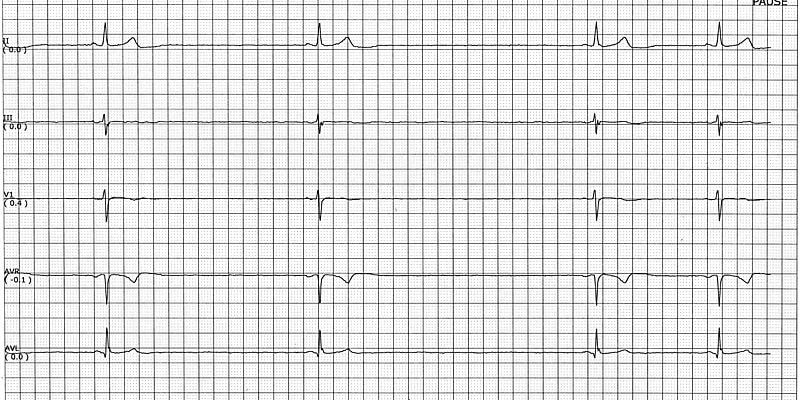Minimizing atrial pacing does not alter the risk of atrial fibrillation (AF) associated with sinus node dysfunction (SND), suggest results of a trial that randomly assigned patients with SND who had received their first pacemaker implant to one of two pacing programs.
Over 2 years of follow-up with remote monitoring, there was no difference in the primary endpoint of time to first device-detected episode of AF lasting more than 6 minutes, reported Max Brix Kronborg, MD, PhD, Department of Cardiology, Aarhus University Hospital, Denmark.
The study, DANPACE II, excluded patients with permanent or persistent AF or persistent bradycardia prior to or at the time of enrollment.
The findings were presented August 28 at the European Society of Cardiology (ESC) Congress 2023 and were published online simultaneously in the European Heart Journal.
The 539 participants in the trial were randomly assigned in a 1:1 ratio to a pacing program of 60 beats/min with rate-adaptive pacing (DDR-60) or 40 beats/min without rate-adaptive pacing (DDD-40). All patients were equipped with remote monitoring and were followed for 2 years. Tracings were adjudicated for atrial high-rate episodes by experienced device specialists, Kronborg said.
No Difference Seen in Primary Outcome
When graphed, curves for the primary outcome in the two groups were essentially superimposable. For the secondary outcomes of AF lasting more than 6 hours and AF lasting more than 24 hours, there was a modest but progressive separation in the lines favoring the DDR-60 group for both. However, the P value did not approach significance in the first of these endpoints (P = .35) and remained only a trend (P = .08) in the second.
There were no substantial differences in results when patients were stratified by age (>73 years vs younger), gender (women represented 50% of patients), PR interval (>150 ms vs less), or history of AF prior to study entry; the latter group represented approximately 40% of the trial participants.
There was a between-group difference in the primary composite safety endpoint of syncope and presyncope. By 2 years, 13% of those in the DDR-60 group had experienced one of these safety events, vs 22% (P = .01) of the DDD-40 group.
The study was not designed to determine a cause for these episodes, but Kronborg reported that bradycardia was suspected in the majority of cases.
Crossovers More Common on Minimal Pacing
Crossovers were permitted, and 26% of patients did so at some point in the trial. Of these, about one third were switched to the opposite arm in response to syncope. Almost all of the others crossed over because of chronotropic incompetence. The greater crossover rate in the DDD-40 group (23% vs 3%; P < .001) was highly significant.
Quality of life was measured with the SF36 tool, and physical function was evaluated with the 6-minute walk distance test (6MWD). Results on these measures did not differ significantly between groups. For 6MWD, the mean gain from baseline was 8 m in both groups.
The results of this study are important because they challenge what has been a widely held perception among electrophysiologists, according to Cecilia Linde, MD, PhD, a professor of cardiology at the Karolinska Institute, Stockholm, Sweden.
“I think many of us involved in pacing thought for many years that minimizing pacing would be beneficial, and this clearly shows it is not,” said Linde, who was the moderator of the scientific session in which these results were presented.
Results Appear Definitive
The ESC-invited discussant, Jose L. Merino, MD, PhD, director of arrhythmia and electrophysiology research, La Paz University Hospital, Madrid, Spain, concurred. He said these results are convincing.
On the basis of these findings, which not only failed to show a benefit but showed in the experimental arm a higher incidence of syncope and chronotropic incompetence, Merino concluded, “Programming intended to minimize atrial pacing should not be used as routine in unselected patients with SND.”
A trend for protection from DDR-60 over DDD-40 from the longest episodes of AF caught Merino’s attention, leading him to question whether the optimal rate of pacing might be even higher than 60 beats/min in SND, but he said that that is a separate issue. DANPACE was not powered to examine the effect in long duration episodes.
Ultimately, while Merino characterized the increased risk of syncope with minimized pacing as “an important finding” in regard to dissuading clinicians to pursue this strategy, he said that the underlying question of the DANPACE trial remains unanswered.
Pacing remains “a treatment of choice” in SND, but there further investigation is needed “about the optimal pacing rate to minimize AF and syncope” in this population, he said.
Kronborg reports a financial relationship with Abbott. Linde reports financial relationships with Cardio 3, Medtronic, St. Jude, and Vifor. Merino reports financial relationships with Abbott, Medtronic, and Microport.
European Society of Cardiology (ESC) Congress 2023: Presented August 28, 2023.
Eur Heart J. Published online August 28, 2023. Abstract, Editorial
For more news, follow Medscape on Facebook, X, Instagram, and YouTube.
Source: Read Full Article
